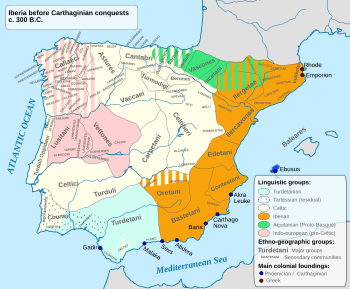Varduli facts for kids
The Varduli were an ancient tribe living in the northern part of the Iberian Peninsula before the Romans arrived. Today, this area is the eastern part of the Basque Country and western Navarre in northern Spain. Their land is now where the Basque language is spoken. However, experts still discuss if the Varduli were related to the Vascones (who spoke an early form of Basque) or if they were Celts, like the Cantabri and Celtiberians. Some believe they later started speaking Basque.
Contents
What Does "Varduli" Mean?
The name Varduli is linked to an area called Bardulia in old documents from the Middle Ages. This area is thought to be where Old Castile began. A Spanish expert named Julio Caro Baroja said that the name Varduli does not come from the Basque language.
History of the Varduli Tribe
The Varduli are first mentioned by Roman writers.
Early Roman Mentions
The Greek writer Strabo called them Bardyetai. He placed them on the Basque coast, between the Cantabri and Vascones tribes. Another geographer, Ptolemy, placed them in what is now Gipuzkoa. The Roman historian Pliny the Elder wrote in his book Naturalis Historia that Amanum Portus (now Castro Urdiales) was a Varduli city.
The Roman geographer Pomponius Mela also placed them on the coast, west of the Vascones. These different locations might be because tribes in northern Iberia moved around a lot, especially during wars like the Cantabrian Wars. The first count of the Varduli people was ordered by the Roman emperor Augustus.
Varduli Cities
According to Pliny the Elder, the main Varduli city was Tullonium. This city was in the Zadorra river area, on a major Roman road. This road went from Virovesca (the capital of the Autrigones) to Pompaelo (modern Pamplona) in Vasconian land.
Other Varduli cities mentioned by Roman writers like Ptolemy and Pomponius Mela included:
- Alba and Gebala (today's Guevara) were inland.
- Tritium Tuboricum, Menosca, and Morogi were on the Atlantic coast (near the Bay of Biscay).
Varduli in the Roman Army
In 114 BC, a Roman general named Gaius Marius had a personal guard made up of Varduli people. They were called Barduaioí slaves in Rome. By the year 44 AD, the Varduli lived near the Pyrenees mountains and were a united group.
The Varduli were not affected by the defeat of the Cantabri against Augustus, as they had not joined those wars. Varduli soldiers also served in Roman army units called cohorts in the province of Britannia (modern-day Britain). Inscriptions found in Britain mention the First Cohort of Varduli, who were cavalrymen. These inscriptions include dedications to "Matres" (mother goddesses).
Their Language and Origin
Just like with the Caristii tribe, experts debate if the Varduli were an Aquitanian tribe or a Celt one. Their place names (toponyms) were clearly from an Indo-European language, likely Proto-Celtic language. For example:
- Uxama means "the highest."
- Deobriga means "holy hill."
- Tullonium means "valley."
River names (hydronyms) like Deva or Deba (meaning "Goddess") were also Indo-European. No place names linked to the Aquitanian or Proto-Basque languages have been found. This supports the idea that they were Celtic and might have later started speaking Basque. However, most modern place names in the area are Basque, sometimes mixed with Latin or Romance words.
Later History and Disappearance
The last mention of the Varduli is in a chronicle by Hydatius. He wrote about the damage caused by the Heruli tribe when they attacked the Cantabrian coast in 400 AD and again in 456 AD after attacking Bardulia.
Ad sedes propias redeuntes, Cantabriarum et Vardaliarum loca maritima crudelissime deproedatio sunt.
Later, in the next century, Saxons from the Bordeaux area also raided along the coast.
Some believe the Varduli started speaking Basque because the Vascones tribe moved into their territory. The Varduli are not mentioned again in the Early Middle Ages. In their place, the area became known as the beginnings of the province of Gipuzkoa.
Some historians think that the Caristii, Autrigones, and Varduli tribes might have been related or worked together. Later, they might have all been grouped under the name Varduli. This could explain why the Caristii and Varduli seemed to lose their names and were grouped with the Autrigones. These tribes took refuge in coastal areas from attacks by the Islamic powers from Al-Andalus. This area later became a frontier region of the Kingdom of Asturias in the 8th century, known as Castile. This union of Varduli, Caristii, and Autrigones eventually led to the County of Bardulia, which was part of the Crown of Castile.
The coat of arms of the Basque province of Gipuzkoa says "Fidelissima Bardulia, Nunquam Superata". This means "Most loyal Bardulia, never conquered."
See also
 In Spanish: Várdulos para niños
In Spanish: Várdulos para niños
- Pre-Roman peoples of the Iberian Peninsula
- Caristii
- Autrigones
- Cantabri
- Vascones
- Origin of the Basques


